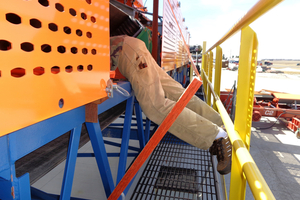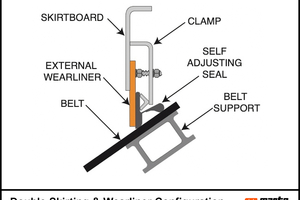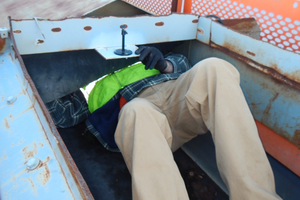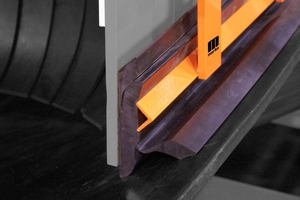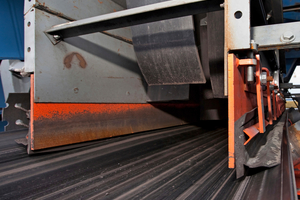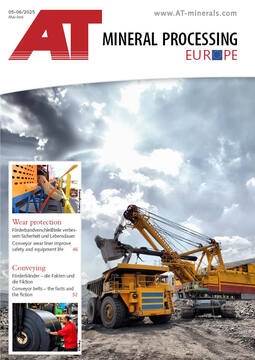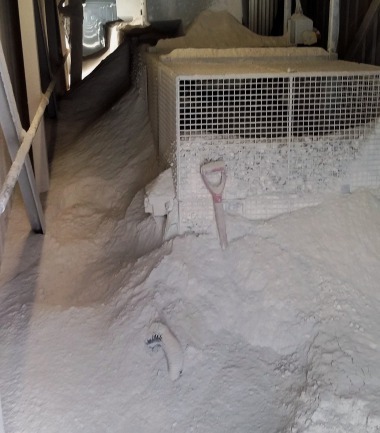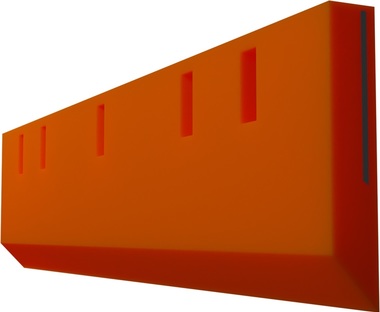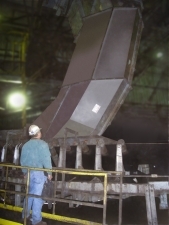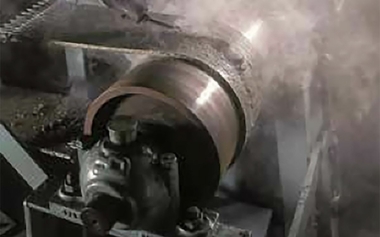Conveyor wear liner improve safety and equipment life
When quarry operators load the conveyor with heavy raw material, the wear liner on a belt conveyor transfer point protects the loading zone enclosure from severe abrasion and is essentially considered a sacrificial layer. Removal and replacement of this layer are challenging tasks requiring multiple workers and several days of scheduled downtime. Conventional wear liners have traditionally been installed inside the chute, but modern designs are positioned on the outside, enhancing skirtboard sealing and preventing spillage.
The goal of the external design is to significantly reduce installation and service time while minimizing risk and enhancing safety. The result is an optimized performance with fewer labor hours, no required certification for maintenance, and lower operational costs.
Rethinking chute design
Previous designs securely welded the wear liner to the inside of the chute, with only the skirt seal located on the outside. The logic behind the conventional design is for the wear liner to protect the skirtboard, which is typically approx. 0.65 cm sheet metal and not strong enough to withstand the sustained force and abrasion from bulk material.
Instead, Martin Engineering designers came up with the idea of raising the chute work about 10.16 cm above the belt, out of the way of the material, then putting the wear liner on the outside. Using this approach, the material still hits the liner and doesn’t damage the chute. The engineers were surprised that no one had tried this option before, as it had some obvious benefits.
After elevating the chute box above the material flow, a 0.95 cm or 1.27 cm thick abrasion-resistant liner plate (AR500) is mounted on the outside of the chute, followed by the skirt seal. Mounting brackets with jackscrews ensure a tight hold and allow for precise adjustment of the wear liner to reduce spillage. This system closes the gap between the liner and the sealer, eliminating abrasion from trapped material without interfering with existing supports. When accompanied by skirting and clamps, the system forms a tight belt seal, providing outstanding control of fugitive material.
Safer by design
When a conventional wear liner loses its edge, the replacement procedure is described by operators as an undesirable maintenance assignment. The authorized entrant would enter the chute with a grinder to remove the welds and detach the sacrificial liner, which may have required a torch to cut away the existing material.
This can be extremely dangerous for two reasons. First, the liner can weigh several hundred pounds, and when a worker cuts it loose, it can fall and endanger the personnel inside the chute’s confined space. Second, nearly any dust can be explosive under the right conditions and grinding or torch-cutting the old liner introduces a spark or open flame.
Some companies thoroughly wash out the chute prior to entry to avoid any chance of combustible particulates, making the job even more time-consuming. Once the old liner had been removed, the new wear liner was positioned to keep it as close to the belt as possible and welded into place.
Installing an external wear liner
An external liner can be installed and adjusted more quickly and easily, without needing a grinder or torch, by using special mounting tabs. Clips for securing the liner are initially welded in place but do not need to be removed when the liner wears out. Since the work is performed from the outside, without any grinding sparks or torch flames, the risk of explosive dust from tool usage is significantly reduced. Replacement liners are available in a standard length of 1829 mm, and Martin Engineering uses laser cutting technology to create the complex geometries necessary for a custom fit.
The new liner is easily retrofitted onto existing equipment. Installers simply cut back the chute wall on existing chute boxes to accommodate the external wear liner. On new installations, the chute is easily engineered to work with the new liner design, as well as other Martin Engineering components such as dust curtains, track-mounted idlers and cradles.
Case study – ArcelorMittal port terminal
An ArcelorMittal port terminal in Indiana was experiencing excessive spillage, tail pulley fouling and belt tracking issues with a petroleum coke transfer point on the stacker/reclaimer boom conveyor. Material spilled out the sides of the chute and piled onto the floor, creating a hazard and requiring workers to be reassigned from other duties several times per month to clean, increasing labor costs. Moreover, the spillage was getting onto the return side of the belt and fouling the tail pulley, causing loading and tracking issues. Operators attempted to remedy the situation by having a new transfer chute built. However, once installed, operators realized that the problem was not with the vertical chute, but the loading zone and settling zone equipment. These were onerous and time consuming to service requiring a maintenance team with confined space entry permits which extended downtime and diverted experienced staff from other important tasks.
Managers invited Martin Engineering to examine the issue and offer solutions. After conducting a thorough Walk the Belt™ procedure, technicians installed external wear liners, ApronSeal™ Double Skirting HD (heavy-duty), Trac-Mount™ Idlers, Upper and Lower Trackers, and a V-Plow. The wear liner protects the chute wall against punishing material as the double skirting forms a seal that rides lightly on the belt, keeping fines from escaping. The wear liners and skirts are externally mounted for safe and easy maintenance with no confined space entry required. To retain a true belt path, technicians installed upper and lower tracking technology and 35º idlers that slide out for faster one-person maintenance. To protect the tail pulley, a V-Plow was installed to deflect fugitive material on the belt return.
Three Martin technicians and 6 contractors completed the installation project over 2 shifts (12-hour and 14-hour). The chute was tested several times and adjusted until the proper trough angle and belt seal were achieved. After several boatloads, the customer reported “not a single pellet has hit the deck.” Along with a near-complete elimination of spillage, operators said that the tracking issues were also resolved and the tail pulley has had no incidents of fouling from return side debris. Moreover, the reduction in labor reduced the cost of operation. Managers are currently working with Martin Engineering on other projects.
Safety in design
An external wear liner could be considered a safety device since it eliminates the need to expose maintenance staff to a potentially hazardous activity like confined space entry. Moreover, the external wear liner and skirting configuration extend the life of the equipment and the chute, while reducing spillage and dust. Retrofitting the transfer chute with updated equipment improves system performance with no required certification for maintenance, which reduces the number of workers and hours to replace and service, in turn lowering the cost of operation.

